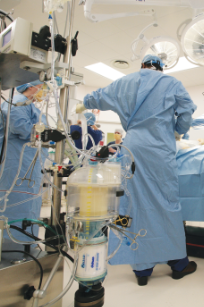News / Providers raise concerns over revised marginal rate
 NHS England and NHS Improvement published changes to national tariff plans as part of a new consultation at the end of February. The original proposals included in December’s consultation said that a new aligned payment and incentive approach would be introduced from April. This involves a fixed payment to fund an agreed level of activity plus a variable element, primarily to pay for additional activity above the agreed baseline or to withdraw funds for shortfalls in activity.
NHS England and NHS Improvement published changes to national tariff plans as part of a new consultation at the end of February. The original proposals included in December’s consultation said that a new aligned payment and incentive approach would be introduced from April. This involves a fixed payment to fund an agreed level of activity plus a variable element, primarily to pay for additional activity above the agreed baseline or to withdraw funds for shortfalls in activity.
The initial consultation suggested that trusts over-performing against agreed elective activity levels should receive 75% of national or unit prices for additional work. But trusts that underperformed against the baseline would have faced deductions at a rate of 50%.
The new consultation harmonises the marginal rate at 75% for both additional payments and deductions. The change aligns the rates with those proposed for commissioning bodies as part of the elective recovery funding proposals. It argues that 75% is an appropriate rate as analysis of patient-level cost data shows that, on average, 25% of elective activity costs are fixed, with the remaining 75% relating to staffing and purely variable costs.
However, NHS Providers chief executive Chris Hopson said there were often good reasons for trusts missing stretch targets and there was concern this change would leave them underfunded compared with their significant fixed cost base.
“Reasons beyond a trust’s control in 2022/23 could include the impact of current and future waves of Covid-19, pressures in urgent and emergency care, the impact of current workforce shortages, and pressures in social care, given their impact on bed capacity,’ he said. These factors were already constraining trusts with varying impact.
‘It’s right to set very stretching targets here,’ he said. ‘But it’s also vital that any financial regime is appropriately flexible and recognises the legitimate variation that may occur. Otherwise trusts risk being driven into financial problems that will affect their ability to deliver safe and effective care.’
He added that significant care backlogs also existed in mental health and community services, which also needed funded plans.
Draft guidance was also released in February setting out the mechanism for additional elective recovery funding for 2022/23. The planning guidance for the year requires systems to deliver over 10% more elective activity than before the pandemic. This is measured in terms of completed referral-to-treatment pathways.
However, the guidance said that this target would be met with delivery of 104% of value-based activity – measured as 104% of the 2019/20 activity valued at healthcare resource group and treatment function code level using the 2022/23 tariff.
The difference between the 104% and 110% targets is primarily because a planned increase in pre-referral advice and guidance means more pathways will be completed in primary care. This is expected to contribute about six percentage points towards the completed pathways target. However, the contribution towards the value-based activity target is expected to be less than one percentage point, as the value of these pathways is significantly lower than the value of an average pathway.
Commissioners have been given additional elective funding to enable them to deliver
the 104% value-based activity target across elective ordinary, day case, outpatient procedures and first and follow-up outpatient attendance activity.
This will be adjusted up or down by 75% of the tariff value if actual activity across the system is above or below this baseline value.
Any downwards adjustment will be by a maximum of 75% of the initial allocation from the £2.3bn national fund. This is known as the elective funding adjustment floor.
The elective recovery guidance underlines that providers will also earn or lose 75% of the difference in value for elective activity that differs from plan – with the consultation on the tariff specifically reissued to deliver alignment between the two sets of rules.
This means there is alignment between the way systems receive or lose elective recovery funding and how provider remuneration is adjusted to reflect activity differences.
Independent sector care will be treated differently, with additional activity paid at 100% of tariff rates both for activity directly commissioned by commissioners and activity subcontracted by NHS providers. This will depend on the system delivering over 104% of independent sector activity and 104% of elective activity overall. This will mean monitoring performance against baseline, through the secondary uses service data warehouse, broken down by provider activity, subcontracted activity and directly commissioned capacity.
Subcontracted activity is now being excluded from the aligned payment and incentive arrangements and will instead be subject to tariff prices. This addresses a concern, raised by the HFMA in its response to the original tariff consultation, that providers wanting to make extra use of the independent sector to make further progress with waiting lists would have faced being paid at 75% of tariff prices, but having to pay subcontractors 100% of the tariff.
Related content
This event focused primarily on the use of costing information and the importance of working with others to turn data into business intelligence.
This conference will keep all those involved with NHS charities up to date with any changes to practices and procedures.